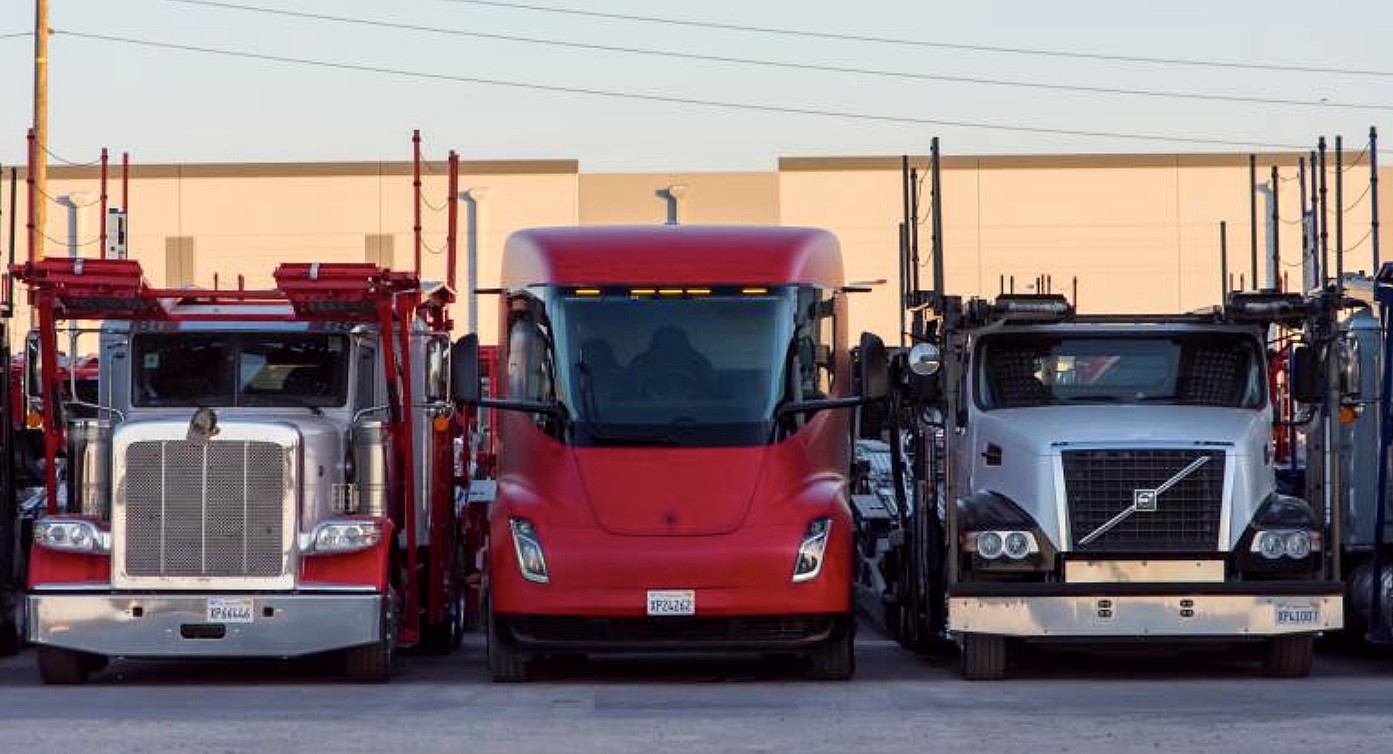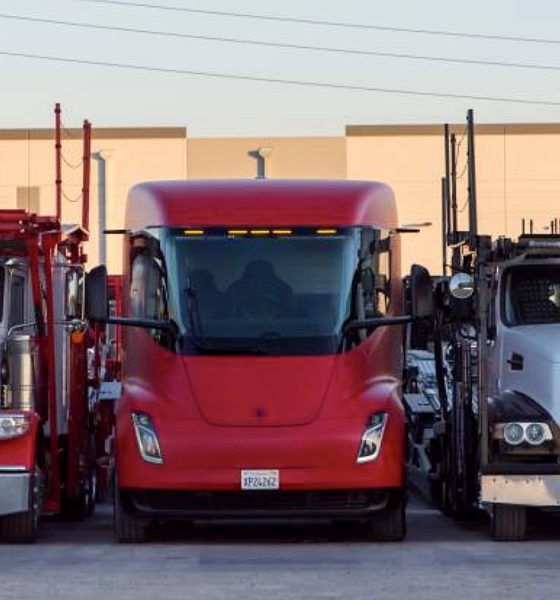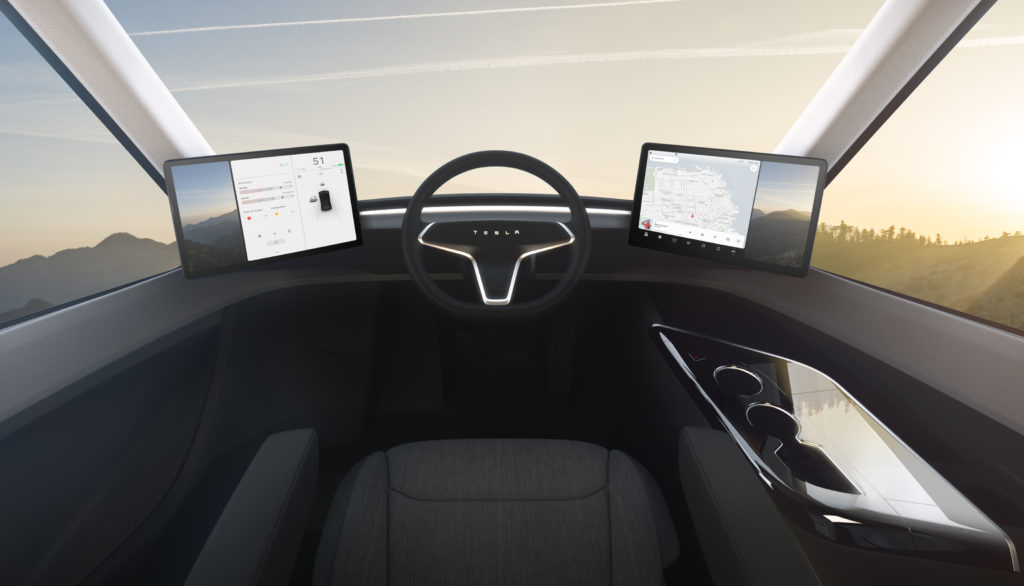

News
Tesla Semi’s spacious cabin highlighted in side-by-side picture with diesel trucks
A recently shared photo of the Semi beside a couple of conventional vehicle delivery trucks was shared by Tesla’s Automotive President Jerome Guillen on LinkedIn. Tesla’s long-hauler definitely looks like it came from the future, thanks to its unique design, cavernous cabin, and central driving position.
Even though the Semi has been spotted in multiple locations over the years, it has rarely been photographed alongside more traditional long haul trucks. This made it a bit challenging to see just how physically different the Tesla Semi was compared to its competition. That is, at least, until Jerome Guillen’s recent LinkedIn post, which depicted the Semi alongside the very vehicles it is intended to replace.
Guillen posted the Semi’s image with a caption, saying, “Quick respite after strong Q2 deliveries. The space alien did come to rescue the dinosaurs.” The Automotive President didn’t specify what his caption was about, though he seemed to be referring to the Semi and its more conventional peers, as well as the role that the all-electric truck played in Tesla’s recent end of quarter push.
A look at the recently shared image highlights the Semi’s large and spacious cabin, especially compared to the two traditional delivery trucks beside it. The Semi’s wraparound windshield, apart from giving drivers a commanding view of the road and excellent visibility, gives the all-electric truck a notably futuristic look. The Semi’s central driving position, which is unapologetically futuristic in its own right, ties the vehicle’s look together.
Ultimately, Guillen’s post highlights a prominent theme in Tesla’s history: the steady transition from tried and tested fossil fuel conventions to the potential presented by sustainable solutions. The Tesla Semi could address most of the problems plaguing the trucking industry today, after all. For example, with its Convoy Mode, Tesla Semi makes driving trucks a little safer.
Previous reports have emerged suggesting that finding drivers in the trucking industry has been difficult as of late despite decent wages, simply because some drivers aren’t willing to take on the health risks caused by the job. The Tesla Semi, with its zero-emissions nature, and its features such as Convoy Mode, which could make driving easier, alleviates some of that risk.

Tesla has been conducting road tests with the Semi since it unveiled the all-electric Class 8 truck back in late 2017. Since then, Tesla’s two Semi prototypes have been put through the paces. Recently, the red wrapped unit was even spotted undergoing winter testing in Tesla’s facility in Alaska.
A recent Elon Musk email revealed that the Tesla Semi is poised to enter volume production soon. Considering that Musk was confident enough to move the Semi into volume production, the all-electric Class 8 truck’s final specifications and design are likely being ironed out if they aren’t already.
The Tesla Semi was announced with a range of either 300 or 500 miles, but Elon Musk has mentioned that the production version of long hauler could have closer to 600 miles of range. With Tesla Battery Day tentatively scheduled for September, Musk’s statements about the production Semi’s range may very well prove to be accurate.

News
Tesla FSD fleet is nearing 7 billion total miles, including 2.5 billion city miles
As can be seen on Tesla’s official FSD webpage, vehicles equipped with the system have now navigated over 6.99 billion miles.

Tesla’s Full Self-Driving (Supervised) fleet is closing in on almost 7 billion total miles driven, as per data posted by the company on its official FSD webpage.
These figures hint at the massive scale of data fueling Tesla’s rapid FSD improvements, which have been quite notable as of late.
FSD mileage milestones
As can be seen on Tesla’s official FSD webpage, vehicles equipped with the system have now navigated over 6.99 billion miles. Tesla owner and avid FSD tester Whole Mars Catalog also shared a screenshot indicating that from the nearly 7 billion miles traveled by the FSD fleet, more than 2.5 billion miles were driven inside cities.
City miles are particularly valuable for complex urban scenarios like unprotected turns, pedestrian interactions, and traffic lights. This is also the difference-maker for FSD, as only complex solutions, such as Waymo’s self-driving taxis, operate similarly on inner-city streets. And even then, incidents such as the San Francisco blackouts have proven challenging for sensor-rich vehicles like Waymos.
Tesla’s data edge
Tesla has a number of advantages in the autonomous vehicle sector, one of which is the size of its fleet and the number of vehicles training FSD on real-world roads. Tesla’s nearly 7 billion FSD miles then allow the company to roll out updates that make its vehicles behave like they are being driven by experienced drivers, even if they are operating on their own.
So notable are Tesla’s improvements to FSD that NVIDIA Director of Robotics Jim Fan, after experiencing FSD v14, noted that the system is the first AI that passes what he described as a “Physical Turing Test.”
“Despite knowing exactly how robot learning works, I still find it magical watching the steering wheel turn by itself. First it feels surreal, next it becomes routine. Then, like the smartphone, taking it away actively hurts. This is how humanity gets rewired and glued to god-like technologies,” Fan wrote in a post on X.
News
Tesla starts showing how FSD will change lives in Europe
Local officials tested the system on narrow country roads and were impressed by FSD’s smooth, human-like driving, with some calling the service a game-changer for everyday life in areas that are far from urban centers.

Tesla has launched Europe’s first public shuttle service using Full Self-Driving (Supervised) in the rural Eifelkreis Bitburg-Prüm region of Germany, demonstrating how the technology can restore independence and mobility for people who struggle with limited transport options.
Local officials tested the system on narrow country roads and were impressed by FSD’s smooth, human-like driving, with some calling the service a game-changer for everyday life in areas that are far from urban centers.
Officials see real impact on rural residents
Arzfeld Mayor Johannes Kuhl and District Administrator Andreas Kruppert personally tested the Tesla shuttle service. This allowed them to see just how well FSD navigated winding lanes and rural roads confidently. Kruppert said, “Autonomous driving sounds like science fiction to many, but we simply see here that it works totally well in rural regions too.” Kuhl, for his part, also noted that FSD “feels like a very experienced driver.”
The pilot complements the area’s “Citizen Bus” program, which provides on-demand rides for elderly residents who can no longer drive themselves. Tesla Europe shared a video of a demonstration of the service, highlighting how FSD gives people their freedom back, even in places where public transport is not as prevalent.
What the Ministry for Economic Affairs and Transport says
Rhineland-Palatinate’s Minister Daniela Schmitt supported the project, praising the collaboration that made this “first of its kind in Europe” possible. As per the ministry, the rural rollout for the service shows FSD’s potential beyond major cities, and it delivers tangible benefits like grocery runs, doctor visits, and social connections for isolated residents.
“Reliable and flexible mobility is especially vital in rural areas. With the launch of a shuttle service using self-driving vehicles (FSD supervised) by Tesla in the Eifelkreis Bitburg-Prüm, an innovative pilot project is now getting underway that complements local community bus services. It is the first project of its kind in Europe.
“The result is a real gain for rural mobility: greater accessibility, more flexibility and tangible benefits for everyday life. A strong signal for innovation, cooperation and future-oriented mobility beyond urban centers,” the ministry wrote in a LinkedIn post.
News
Tesla China quietly posts Robotaxi-related job listing
Tesla China is currently seeking a Low Voltage Electrical Engineer to work on circuit board design for the company’s autonomous vehicles.

Tesla has posted a new job listing in Shanghai explicitly tied to its Robotaxi program, fueling speculation that the company is preparing to launch its dedicated autonomous ride-hailing service in China.
As noted in the listing, Tesla China is currently seeking a Low Voltage Electrical Engineer to work on circuit board design for the company’s autonomous vehicles.
Robotaxi-specific role
The listing, which was shared on social media platform X by industry watcher @tslaming, suggested that Tesla China is looking to fill the role urgently. The job listing itself specifically mentions that the person hired for the role will be working on the Low Voltage Hardware team, which would design the circuit boards that would serve as the nervous system of the Robotaxi.
Key tasks for the role, as indicated in the job listing, include collaboration with PCB layout, firmware, mechanical, program management, and validation teams, among other responsibilities. The role is based in Shanghai.
China Robotaxi launch
China represents a massive potential market for robotaxis, with its dense urban centers and supportive policies in select cities. Tesla has limited permission to roll out FSD in the country, though despite this, its vehicles have been hailed as among the best in the market when it comes to autonomous features. So far, at least, it appears that China supports Tesla’s FSD and Robotaxi rollout.
This was hinted at in November, when Tesla brought the Cybercab to the 8th China International Import Expo (CIIE) in Shanghai, marking the first time that the autonomous two-seater was brought to the Asia-Pacific region. The vehicle, despite not having a release date in China, received a significant amount of interest among the event’s attendees.








